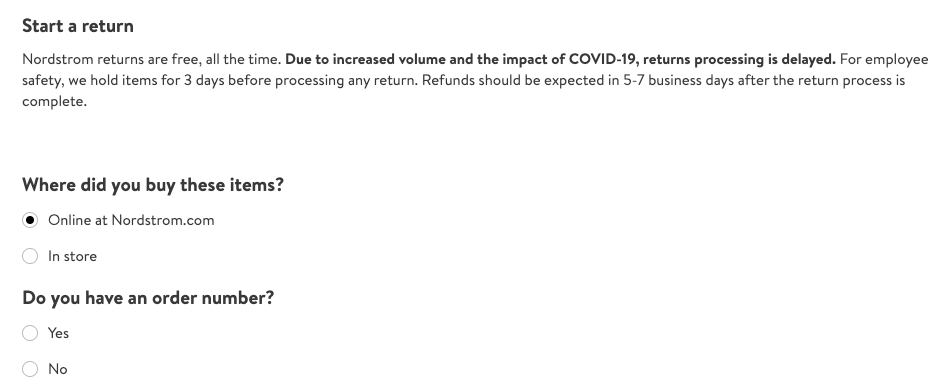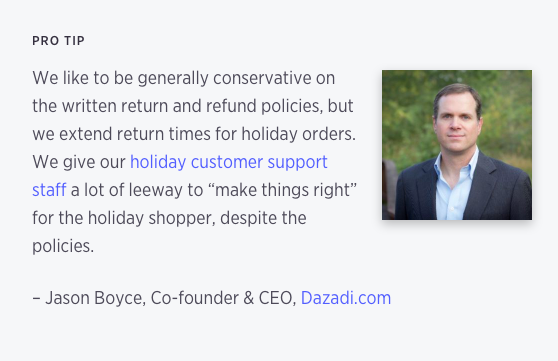As a business, returns can be costly and disappointing. In 2019, online returns lost businesses in the United States a total of $41 billion. Companies losing thousands, even millions of dollars in this process may question the importance of building a satisfying return policy for their e-commerce business.
The answer lies in customer satisfaction and buyer behavior. According to UPS data, 73% of consumers make their decisions to purchase again from a retailer at least somewhat based on the quality of their returns experience with them.
A customer that isn’t anxious about a potentially difficult, unsuccessful, or negative returns experience will be more encouraged to buy from online retailers. In those situations, they don’t need to hesitate when they click “confirm purchase.”
Retail businesses will benefit from building a returns policy around customer satisfaction or adjusting their current policy to reflect their care for loyal customers. This article will offer 3 steps for crafting a returns policy that enhances your customer experience.
Keep Policies Straightforward
Arguably, the most important aspect of a returns policy is that your customers can easily find and understand it. This means that you have to keep your written policy clear and straightforward.
Part of having a positive customer experience is the satisfaction of knowing that the retailer and customers are on the same page with regards to returns. Companies that succeed in keeping their copy straightforward address the following questions with concision on their website.
- How should returns be packaged?
- How long does a customer have to return the product?
- What is your refund policy?
- How do you handle potential cases of fraud?
- Who is expected to cover the cost of shipping?
These and any other pertinent information specific to your process should be included to demonstrate transparency and assist customers as they navigate the process. The more quickly they can get essential questions answered, the more satisfied they’ll be with your returns policy.
While this may seem like a lot of technical information to include, it’s critical to make your policy simple and easy to follow. Companies like American Eagle achieve this through a returns policy that is prominently displayed on their site.

Source: American Eagle
Quickly, a reader can get answers to many of their essential questions within just a few lines of text. Most importantly, the policy assures customers that they should expect a full refund for their return unless there is an abuse of policy found.
Presenting this clarity and straightforwardness upfront in your return policy is essential to managing your customer’s expectations for your services.
Offer Free Returns
Customers will respond positively to your returns experiences if you are able to offer free shipping on their returns.
According to UPS, 60% of consumers are most satisfied with a returns system that offers free returns. Shipping items is already seen as a hassle for customers, and the cost of shipping only compounds that inconvenience.
Paying for shipping worsens a customer’s experience with the returns process, making them less likely to buy from you in the future. This is because they’ll feel a stronger sense of hesitation when deciding to make a final purchase on your site, in efforts to avoid another negative experience.
In this way, free returns have been especially effective for companies relying on large purchases. A study found that shoppers are 17% more likely to make a purchase of over $1,000 if there is a free return policy in place.
Knowing that they’ll be able to make a hassle-free return if needed, people are more willing to make more expensive purchases that may be considered risky without a free return option.
Nordstrom prioritizes customer service in their online returns process, ensuring customers that they can make their return for free.

Source: Nordstrom
This process encourages shoppers to engage with the brand and make more purchases there because the free returns policy has minimized risk associated with purchasing.
Free returns may be costly to you in the short term but showing empathy and understanding for consumers when they’re not satisfied with a purchase will make a huge difference in your efforts to retain loyal buyers.
Give Customers Time to Make the Return
Oftentimes, customers may feel pressured to make a quick decision to return a product due to the quick turnaround times called for by return policies.
This is especially the case with purchasing around the holidays and when customers are intending the product to be a gift for someone else.
In these cases, the product isn’t opened or used right away. Weeks and months can go by before the intended user sees it for the first time and is able to determine whether or not they may want to make a return.
Some companies like Dazadi have taken note of this need and have altered their regular return policies to offer more leeway for holiday shoppers and gift buyers around large holidays.

Source: BigCommerce
While their co-founder admits to normally having a relatively conservative policy, the expanded holiday return offerings encourage customers to make more purchases without worrying about their ability to make a return later.
The very common, almost standard time allowed by return policies for refunds is 30 days. However, this may not always be enough time for customers to make their decision. However, the longer your company allows returns to be made, the higher chances of use, fraud, and abuse of the policy.
To avoid the negative associated with more lenient return policy timelines, companies have listed stimulations to allow customers more time for their decisions without accepting potential damage or additional loss.
For instance, Zappos offers a full refund for returns made within a year of purchase.

Source: Zappos
However, the footwear company requires the products to be unworn and in the same state as they were received. They also require the security tag to be present, all ensuring that the product has not been worn with the intention of returning and is still in the same condition it was at the point of purchase.
If time is something that you foresee your customers needing to determine whether or not they’d like to make a return, make sure that you’re allowing them the chance to make their decision with confidence and resolve.
Strong Returns Policies Create Loyal Customers
When customers have a notably positive experience while returning a product, they’re more likely to buy from your company in the future. For that reason, aim to make your customers satisfied with their return experience.
Small businesses can achieve this by clearly explaining their policy on their website. From there, they can look to implement free return policies and flexible return timelines to accommodate the needs of consumers.
Sydney Wess researches and writes about supply chain and technology for Clutch.






Leave A Comment